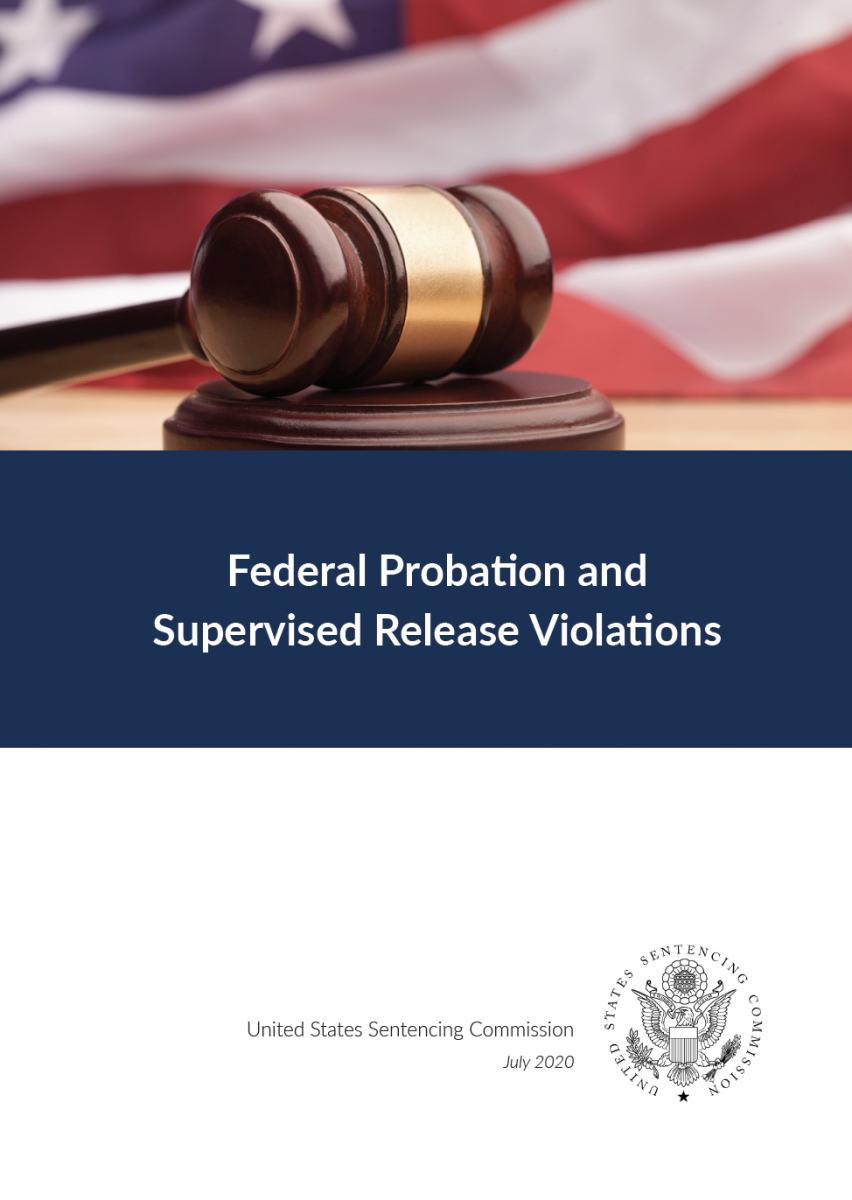Summary
 Federal Probation and Supervised Release Violations presents data on approximately 108,000 violation hearings that occurred between 2013 and 2017. The report examines the prevalence, types, and locations of federal supervision violations as well as the characteristics of more than 82,000 violators. The report also compares supervision violators to the population of federal offenders originally sentenced to probation or a sentence including a term of supervised release during the same time period. (Published July 28, 2020)
Federal Probation and Supervised Release Violations presents data on approximately 108,000 violation hearings that occurred between 2013 and 2017. The report examines the prevalence, types, and locations of federal supervision violations as well as the characteristics of more than 82,000 violators. The report also compares supervision violators to the population of federal offenders originally sentenced to probation or a sentence including a term of supervised release during the same time period. (Published July 28, 2020)
Key Findings
- Nationally, the number of individuals under supervision was relatively stable during the study period, ranging from 130,224 to 136,156 during the five years. Half of the individuals under supervision, however, were concentrated in only 21 of the 94 federal judicial districts.
-
Nationally, the rate of violation hearings for individuals on supervision also was relatively stable, ranging from 16.2 to 18.4 percent during the five years, with an overall rate of 16.9 percent. The prevalence of supervision violations, however, varied considerably among the federal judicial districts.
- Violations accounted for more than one-third of individuals on supervision in the Southern District of California (42.1%), District of Minnesota (37.4%), Western District of Missouri (34.3%), District of Arizona (33.7%), and District of New Mexico (33.4%). In contrast, violations accounted for less than five percent of individuals on supervision in the Districts of Connecticut (4.5%) and Maryland (4.7%).
-
Supervision violators tended to have committed more serious original offenses than federal offenders whose original sentence was probation or included a term of supervised release during the same time period.
- For example, the rates of supervision violators originally sentenced for violent and firearms offenses (7.9% and 20.4%, respectively) were approximately twice as high compared to offenders originally sentenced during the study period (3.7% and 12.8%, respectively), a finding which is consistent with prior Commission recidivism research.
-
Drug offenses were the most common primary offense type for both supervision violators and federal offenders whose original sentence was probation or included a term of supervised release during the same time period. There were, however, notable variations by drug type.
- For example, crack cocaine offenders accounted for only 9.9 percent of drug offenders whose original sentence was probation or included a term of supervised release, but they accounted for almost one-third (32.1%) of supervision violators, a greater proportion than any other drug type. The disproportional representation of crack cocaine offenders among supervision violators is consistent with prior Commission recidivism research. On the other hand, drug offenders who received the safety valve at their original sentencing were underrepresented among supervision violators (19.1% compared to 30.7%), a finding that also is consistent with prior Commission recidivism research.
-
Supervision violators tended to have more serious criminal histories than federal offenders whose original sentence was probation or included a term of supervised release.
- Approximately one-quarter (24.6%) of offenders with supervision violations were in the lowest Criminal History Category (CHC I) at the time of their original sentencing compared to almost half (44.9%) of offenders whose original sentence was probation or included a term of supervised release during the study period. On the other end of the spectrum, 18.3 percent of offenders with supervision violations were in the highest Criminal History Category (CHC VI) at the time of their original sentencing compared to 9.9 percent of offenders whose original sentence was probation or included a term of supervised release during the study period. This pattern is consistent with prior Commission recidivism research.
-
The majority of supervision violations were based on the commission of an offense punishable by a term of one year or less or a violation of another condition of supervision not constituting a federal, state or local offense (Grade C Violation).
- More than half (54.9%) of violations were Grade C (the least serious classification), nearly one-third (31.5%) were Grade B, and 13.6 percent were Grade A (the most serious classification).
-
Offenders who were originally sentenced for more serious offenses tended to commit more serious supervision violations.
- For example, over four-fifths of the Grade A violations were committed by offenders originally sentenced for drug offenses (52.0%), firearms offenses (24.5%), or violent offenses (6.3%).
-
Offenders who violated their conditions of supervision typically did so within the first two years.
- On average, 22 months elapsed from the time supervision commenced to the commission of the supervision violation, but the elapsed time was notably longer for Grade A violations (the most serious) at 33 months.
-
The majority of supervision violators were sentenced in accordance with the Chapter Seven Revocation Table.
- More than half (59.8%) were within the applicable range, just over one-quarter (29.1%) were below the range, and 11.1 percent were above the range. Courts tended to impose sentences within the applicable guideline range less often for more serious supervision violations. For example, for Grade A violations (the most serious classification), 39.4 percent were sentenced within the applicable range, and 54.2 percent were sentenced below the range. In contrast, for Grade C violations (the least serious classification), 63.6 percent were sentenced within the range, and 22.1 percent were sentenced below the range.
